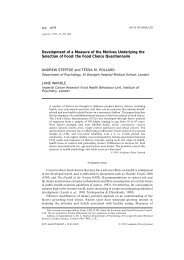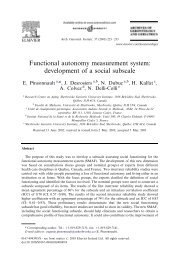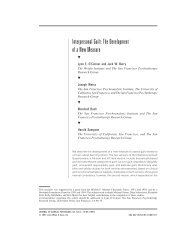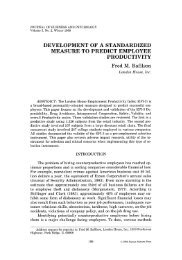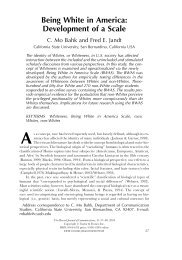Development of a questionnaire for the assessment of ... - PsychWiki
Development of a questionnaire for the assessment of ... - PsychWiki
Development of a questionnaire for the assessment of ... - PsychWiki
Create successful ePaper yourself
Turn your PDF publications into a flip-book with our unique Google optimized e-Paper software.
18 P. Gaudreau, J.-P. Blondin / Psychology <strong>of</strong> Sport and Exercise 3 (2002) 1–34Table 4 (continued)Coping items SL SEJe me suis éloigné dans un endroit favorable à la réflexion (49) 0.683 0.248I retreated where it was easy to think.J’ai recherché le silence (81) 0.726 0.241I searched <strong>for</strong> calmness and quietness.J’ai fait le vide autour de moi (83) 0.578 0.225I kept all people at a distance.Note: English wording <strong>of</strong> items has not been subjected to a back-translation procedure and should not beinterpreted as valid <strong>for</strong> use in research. Number in <strong>the</strong> paren<strong>the</strong>ses represents <strong>the</strong> number <strong>of</strong> an item in <strong>the</strong><strong>questionnaire</strong>. Dashes indicate that <strong>the</strong> parameters were not estimated. All standardized factor loadings aresignificant at p0.05.corrected with a Bonferroni procedure (p=a/10=0.005) in order to prevent <strong>the</strong> occurrence <strong>of</strong> Type-I error (Stevens, 1996). Prior to <strong>the</strong>se analyses, means, standard deviations, and Cronbach’s index<strong>of</strong> internal consistency were calculated <strong>for</strong> <strong>the</strong> WOCQ and MCOPE subscales (see Table 6).Six MCOPE subscales exhibited good internal consistency (0.79a0.90; Kline, 1998) whereasbehavioral disengagement and suppression <strong>of</strong> competing activities exhibited a moderately lowinternal consistency (0.60a0.70; Kline, 1998). All subscales were retained <strong>for</strong> fur<strong>the</strong>r analyses.Concerning <strong>the</strong> WOCQ, <strong>the</strong> confrontation/seeking social support and problem-focused subscales’internal consistency were within reasonable range (0.70a0.80; Kline, 1998) whereas <strong>the</strong>distancing/avoidance subscale’ internal consistency was moderately low (0.60a0.70; Kline,1998). However, <strong>the</strong> denial subscale (a=0.33) exhibited a very low alpha coefficient and wasdiscarded from fur<strong>the</strong>r analyses.Two sets <strong>of</strong> analyses examined <strong>the</strong> relationships between <strong>the</strong> ISCCS and <strong>the</strong> MCOPE subscales,and between <strong>the</strong> ISCCS and <strong>the</strong> WOCQ subscales, respectively. Several ISCCS subscales correlatedsignificantly with <strong>the</strong> subscales <strong>of</strong> <strong>the</strong> MCOPE and <strong>the</strong> WOCQ. Results <strong>of</strong> <strong>the</strong>se analysesare presented in Table 7.Concurrent validityThe relationship between <strong>the</strong> ISCCS subscales and appraisal variables (i.e. perceived goalattainment, perceived relevance <strong>of</strong> <strong>the</strong> competition, and sense <strong>of</strong> control), affective variables (i.e.positive affect, negative affect, cognitive anxiety, somatic anxiety, and confidence), and socialdesirability was assessed with bivariate Pearson correlations using a Bonferroni correction. Priorto <strong>the</strong>se analyses, means, standard deviations, and Cronbach’s index <strong>of</strong> internal consistency werecalculated <strong>for</strong> <strong>the</strong> nine selected variables (see Table 6). All variables exhibited good internalconsistency (a0.80; Kline, 1998), with <strong>the</strong> exception <strong>of</strong> social desirability, which exhibited amoderately low alpha coefficient. All variables were retained <strong>for</strong> fur<strong>the</strong>r analyses.A first set <strong>of</strong> analyses bore on <strong>the</strong> relationship between ISCCS subscales and each appraisalvariable whereas a second set <strong>of</strong> analyses assessed <strong>the</strong> relationship between ISCCS subscales andeach affective variable. Several subscales <strong>of</strong> <strong>the</strong> ISCCS correlated with perceived relevance <strong>of</strong><strong>the</strong> competition, sense <strong>of</strong> control, perceived goal attainment, positive affect, negative affect, cogni-



